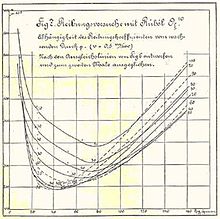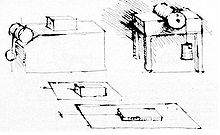- Tribology
-
Tribology is the science and engineering of interacting surfaces in relative motion. It includes the study and application of the principles of friction, lubrication and wear. Tribology is a branch of mechanical engineering.
Contents
Fundamentals
The tribological interactions of a solid surface's exposed face with interfacing materials and environment may result in loss of material from the surface. The process leading to loss of material is known as "wear". Major types of wear include abrasion, friction (adhesion and cohesion), erosion, and corrosion. Wear can be minimized by modifying the surface properties of solids by one or more of "surface engineering" processes (also called surface finishing) or by use of lubricants (for frictional or adhesive wear).
Estimated direct and consequential annual loss to industries in the USA due to wear is approximately 1-2% of GDP. (Heinz, 1987). Engineered surfaces extend the working life of both original and recycled and resurfaced equipments, thus saving large sums of money and leading to conservation of material, energy and the environment. Methodologies to minimize wear include systematic approaches to diagnose the wear and to prescribe appropriate solutions. Important methods include:
- Terotechnology, where multidisciplinary engineering and management techniques are used to protect equipment and machinery from degradation (Peter Jost, 1972)
- Horst Czichos's systems approach, where appropriate material is selected by checking properties against tribological requirements under operating environment (H. Czichos,1978)
- Asset Management by Material Prognosis - a concept similar to terotechnology which has been introduced by the US Military (DARPA) for upkeep of equipment in good health and start-ready condition for 24 hours. Good health monitoring systems combined with appropriate remedies at maintenance and repair stages have led to improved performance, reliability and extended life cycle of the assets, such as advanced military hardware and civil aircraft.
In recent years, micro- and nanotribology have been gaining ground. Frictional interactions in microscopically small components are becoming increasingly important for the development of new products in electronics, life sciences, chemistry, sensors and by extension for all modern technology.
Friction regimes
Friction regimes for sliding lubricated surfaces have been broadly categorized into:
- Solid/boundary friction
- Fluid friction
- Mixed friction
on the basis of the “Stribeck curve”. These curves clearly show the minimum value of friction as the demarcation between full fluid-film lubrication and some solid asperity interactions.
Stribeck and others systematically studied the variation of friction between two liquid lubricated surfaces as a function of a dimensionless lubrication parameter ηN/P, where η is the dynamic viscosity, N the speed (e.g. revolutions per minute of a bearing) and P the load projected on to the geometrical surface.[1]
The “Stribeck-curve” has been a classic teaching element in tribology classes.[2]
History
Historically, Leonardo da Vinci (1452–1519) was the first to enunciate two laws of friction.[3] According to da Vinci, the frictional resistance was the same for two different objects of the same weight but making contacts over different widths and lengths. He also observed that the force needed to overcome friction is doubled when the weight is doubled. Similar observations were made by Charles-Augustin de Coulomb (1736–1806). The first reliable test on frictional wear was carried out by Charles Hatchett (1760–1820) using a simple reciprocating machine to evaluate wear on gold coins. He found that compared to self-mated coins, coins with grits between them wore at a faster rate. The deciphering of da Vinci's work took several centuries, before the development of this branch of science, today called "tribology".
The "Stribeck curve" or "Stribeck–Hersey curve" (named after Richard Stribeck[4][5][6] and Mayo D. Hersey[7][8]), used to categorize the friction properties between two surfaces, was developed in the first half of the 20th century. The research of Professor Richard Stribeck (1861–1950) was performed in Berlin at the Royal Prussian Technical Testing Institute (MPA, now BAM). Similar work was previously performed around 1885 by Prof. Adolf Martens (1850–1914) at the same Institute and in the mid 1870s by Dr. Robert H. Thurston [9][10] at the Stevens Institute of Technology in the U.S. Prof. Dr. Thurston was therefore close to establishing the “Stribeck curve”, but he presented no “Stribeck”-like graphs, as he evidently did not fully believe in the relevance of this dependency. Since that time the “Stribeck-curve” has been a classic teaching element in tribology classes.[2]
The graphs of friction force reported by Stribeck stem from a carefully conducted, wide-ranging series of experiments on journal bearings. Stribeck systematically studied the variation of friction between two liquid lubricated surfaces.[1] His results were presented on 5 December 1901 during a public session of the railway society and published on 6 September 1902. They clearly showed the minimum value of friction as the demarcation between full fluid-film lubrication and some solid asperity interactions. Stribeck studied different bearing materials and aspect ratios D/L from 1:1 to 1:2. The maximum sliding speed was 4 m/s and the geometrical contact pressure was limited to 5 MPa. (These operating conditions were related to railway wagon journal bearings.)
The reason why the form of the friction curve for liquid lubricated surfaces was later attributed to Stribeck, although both Thurston and Martens achieved their results considerably earlier, (Martens even in the same organization roughly 15 years before), may be because Stribeck published in the most important technical journal in Germany at that time, Zeitschrift des Vereins Deutscher Ingenieure (VDI, Journal of German Mechanical Engineers). Martens published his results “only” in the official journal of the Royal Prussian Technical Testing Institute, which has now become BAM. The VDI journal, as one of the most important journals for engineers, provided wide access to these data and later colleagues rationalized the results into the three classical friction regimes. Thurston however, did not have the experimental means to record a continuous graph of the coefficient of friction but only measured the friction at discrete points; this may be the reason why the minimum in the coefficient of friction was not discovered by him. Instead, Thurston's data did not indicate such a pronounced minimum of friction for a liquid lubricated journal bearing as was demonstrated by the graphs of Martens and Stribeck.
The term tribology became widely used following The Jost Report in 1966, in which huge sums of money were reported to have been lost in the UK annually due to the consequences of friction, wear and corrosion. As a result several national centres for tribology were created in the UK. Since then the term has diffused into the international engineering field and many specialists now claim to be tribologists.
There are now numerous national and international societies, such as the Society for Tribologists and Lubrication Engineers (STLE) in the USA and the Institution of Mechanical Engineers' Tribology Group (IMechE Tribology Group) in the UK or the German Society for Tribology (Gesellschaft für Tribologie, www.gft-ev.de).
Most technical universities have a group working on tribology, often as part of their mechanical engineering departments. The limitations in tribological interactions are however no longer mainly determined by mechanical designs, but rather by material limitations so the discipline of tribology now counts at least as many materials engineers, physicists and chemists as it does mechanical engineers.
Etymology
The word 'tribology' derives from the Greek root τριβ- of the verb τρίβω - tribo "Ι rub", and the suffix -logy.
Applications
The study of tribology is commonly applied in bearing design but extends into almost all other aspects of modern technology, even to such unlikely areas as hair conditioners and cosmetics such as lipstick, powders and lipgloss.
Any product where one material slides or rubs over another is affected by complex tribological interactions, whether lubricated like hip implants and other artificial prostheses, or unlubricated as in high temperature sliding wear in which conventional lubricants cannot be used but in which the formation of compacted oxide layer glazes have been observed to protect against wear.
Tribology plays an important role in manufacturing. In metal-forming operations, friction increases tool wear and the power required to work a piece. This results in increased costs due to more frequent tool replacement, loss of tolerance as tool dimensions shift, and greater forces required to shape a piece. A layer of lubricant which eliminates surface contact virtually eliminates tool wear and decreases needed power by one third.[citation needed]
See also
- Tribology Letters[[1]]
- Fretting
- Galling
- List of tribology organizations
- Oil analysis
- Oil additive
- Surface science
- Tribocorrosion
- Tribometer
References
- ^ a b R. Stribeck, Die wesentlichen Eigenschaften der Gleit- und Rollenlager (The basic properties of sliding and rolling bearings), Zeitschrift des Vereins Deutscher Ingenieure, 2002, Nr. 36, Band 46, p. 1341-1348, p. 1432-1438 and 1463-1470
- ^ a b H. Czichos, K.-H. Habig, Tribologie-Handbuch (Tribology handbook), Vieweg Verlag, Wiesbaden, 2nd edition, 2003, ISBN 3-528-16354-2
- ^ Palaci, Ismaël (2007), Atomic Force Microscopy Studies of Nanotribology and Nanomechanics. p. 52.
- ^ Stribeck, R. (1901), Kugellager für beliebige Belastungen (Ball Bearings for any Stress), Zeitschrift des Vereins Deutscher Ingenieure 45.
- ^ Stribeck, R. (1902), Die wesentlichen Eigenschaften der Gleit- und Rollenlager (Characteristics of Plain and Roller Bearings), Zeit. des VDI 46.
- ^ Jacobson, Bo (2003), The Stribeck memorial lecture.
- ^ Hersey, M. D. (1914), The Laws of Lubrication of Horizontal Journal Bearings, J. Wash. Acad. Sci., 4, 542-552.
- ^ Biography of Mayo D. Hersey
- ^ Robert H. Thurston, Friction and lubrication - Determination of the laws and co-ëfficients of friction by new methods and with new apparatus, Trübner and Co., Ludgate Hill, London, 1879
- ^ Robert H. Thurston, A treatise on friction and lost work in machinery and millwork, John Wiley&Sons, New York, 1894, fifth edition
Bibliography
- Surface Wear – Analysis, Treatment, and Prevention: R. Chattopadhyay, published by ASM-International, Materials Park, OH, 2001, ISBN 0-87170-702-0.
- Advanced Thermally Assisted Surface Engineering Processes: Ramnarayan Chattopadhyay, Kluwer Academic Publishers, MA (now Springer, NY), 2004.
- DeGarmo, E. Paul, J T. Black, and Ronald A. Kohser. Materials and Processes in Manufacturing. Upper Saddle River, New Jersey: Prentice Hall, 1997. ISBN 0-02-328621-0
- Zum Gahr, Karl-Heinz (1987). Microstructure and Wear of Materials. Tribology Series, 10. Elsevier. ISBN 0444427546.
- Heshmat, Hooshang. Tribology of Interface Layers. CRC Press. ISBN 978-0824758325.
- Litt, Fred. "Starting from Scratch: Tribology Basics Volume I". STLE. http://www.stle.org/assets/document/Starting_from_Scratch.pdf. Retrieved 2010-06-10.
External links
- Tribology NL an overview of tribology topics targeted at mechanical engineers.
- IET Tribology Network
Categories:- Tribology
- Friction
- Engineering mechanics
- Materials science
- Materials degradation
- Metallurgy
- Mechanical engineering
Wikimedia Foundation. 2010.


